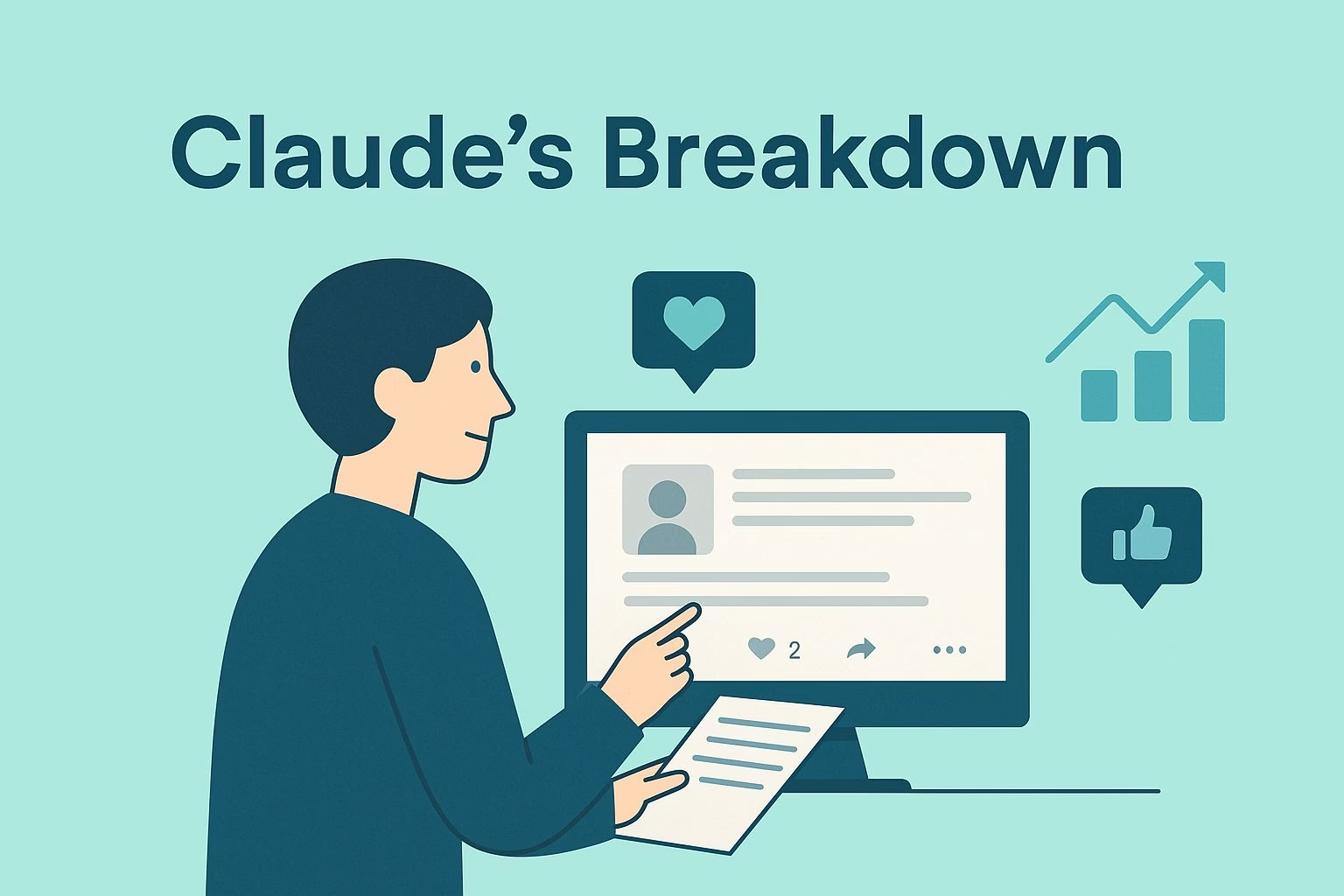Claude analyzed a viral post and revealed the simple structure behind it
Organic social posts have quietly become one of the biggest drivers of revenue for creators who know how to tell a story.
I wanted to understand what made one of my top posts perform so well, so I asked Claude to analyze it. The breakdown was surprisingly detailed and exposed a formula most people overlook.
What Claude found went beyond content hooks or hashtags. It revealed how tone, structure, and emotion work together to turn a short update into something people want to share.
The findings matched what top creators use every day to grow communities, sell offers, and build authority without ads.
The formula is simple, but the psychology behind it explains why some posts go viral while others disappear.
If you rely on organic traffic or want to strengthen your social presence, this breakdown will show what really matters.
Why Claude’s breakdown matters for social growth
Claude’s analysis stood out because it didn’t just describe what worked, it revealed why it worked. Every high-performing post follows a pattern rooted in emotional tension, clarity, and participation.
The top creators who post daily don’t rely on luck; they build around predictable human triggers.
The first discovery was that people don’t share information. They share emotion. A post that opens with a personal story or relatable frustration activates empathy faster than a polished tip ever will.
That’s why Claude highlighted the “villain” structure, an identifiable problem or system the audience recognizes instantly.
When readers see their own frustration mirrored back, they keep reading.
Another key point was how the post transitioned from vulnerability to empowerment. It didn’t just say, “I struggled.” It said, “I struggled, learned, and built something better.”
This shift turned the story from personal to universal, helping others see their potential in the same situation. That emotional pivot is what gets reactions, saves, and comments all at once.
Creators can apply this insight immediately. Before posting, ask:
-
What’s the tension or conflict my audience relates to?
-
How do I show my process of overcoming it?
-
Can I tie it to a larger principle, like growth, community, or self-reliance?
When each post answers those questions, it’s no longer random content. It becomes a story that carries purpose and movement.
The repeatable formula Claude uncovered
Claude’s breakdown revealed a clear structure that makes any organic post more likely to perform.
It’s not about being overly strategic; it’s about guiding emotion and attention.
-
Open with conflict or contrast.
Start with a tension that demands attention. For example, “I spent six months posting daily and got zero traction. Then this one shift changed everything.” The contrast between failure and discovery hooks curiosity. -
Expose vulnerability, then pivot to progress.
Share something imperfect but relatable. Then show what you did differently. This builds trust because it mirrors real growth. -
Tie your story to a universal truth.
Connect your experience to something everyone cares about. It could be learning, resilience, or support. When people see a bigger idea behind your story, they join in emotionally. -
Invite readers into the action.
Don’t just talk at them, include them. For instance: “If you’ve been through this, drop your biggest takeaway below.” That small invitation boosts engagement by signaling community. -
End with direction.
A strong close guides the reader toward the next step. It could be joining your email list, checking a free training, or following for updates. The clarity removes hesitation and builds continuity between posts.
These five steps turn a good post into one that moves people to act. Every successful creator, from freelancers to coaches, follows some version of this sequence whether they know it or not.
Claude’s insight shows that viral posts aren’t accidents. They’re emotional blueprints repeated with different stories. Even without paid promotion, this approach compounds over time.
Consistency turns each post into a trust-building asset that can later support offers or launches.
How creators can apply the same framework
The framework Claude highlighted only works if applied with intention.
Copying surface patterns like bold text or numbered lists will not help if the story lacks emotional truth. What matters is how each element connects to the reader’s experience.
Start with a clear “villain” or source of friction your audience knows too well. It can be an algorithm, a broken routine, or a mindset that keeps them stuck.
Describe it briefly and honestly. People respond faster when they feel seen.
Next, move into your moment of change. Explain what you discovered and how it shifted your outcome. It could be a method, mindset, or new habit that gave better results. Include details that make it believable.
For example, “I replaced my 10-hour content planning sessions with a 15-minute daily reflection. My reach doubled in two weeks.” Specifics give credibility.
Then, connect your story to something universal. Maybe your audience values independence, learning, or connection. Tie your experience to that shared belief.
When a post moves from “me” to “we,” it multiplies engagement. Finish by showing readers how they can take the same action, whether that is trying a small change, joining your newsletter, or commenting with their own example.
Creators who use scheduling or testing tools can improve this process further.
A system like Blaze Autopilot helps organize posting schedules, measure which stories perform best, and identify emotional patterns that keep followers engaged.
Automation supports consistency, but the heart still lies in the story.
Turning engagement into lasting growth
Claude’s analysis did not end with storytelling advice. It connected narrative structure directly to conversion and community building.
Once readers feel emotionally involved, they begin to trust the voice behind the message. That trust is what drives clicks, signups, and returning followers.
The key is continuity. Every post should act as a piece of a larger conversation, not a one-time performance.
When people see familiar themes repeated with honesty, they start anticipating what comes next. This habit is what eventually turns social reach into revenue.
Creators can build that continuity by mapping a few recurring ideas.
For example:
-
A weekly story about lessons learned from failure
-
A regular “behind the scenes” insight that shows transparency
-
A short call-to-action that invites feedback or shared wins
Each theme gives followers a reason to come back while deepening connection. Over time, these patterns form a recognisable voice that stands out in crowded feeds.
Claude’s breakdown proved that growth is not luck but structure. When emotion, rhythm, and clarity work together, even a short social post can generate meaningful results.
The formula is simple, repeatable, and grounded in how people naturally connect.
mistakes to avoid when applying this formula
Many creators see a viral thread and try to replicate it word for word. The problem is that they copy structure but miss the emotional core.
The framework Claude revealed only works when every part feels honest. If it sounds forced or staged, readers scroll past.
The first mistake is over-polishing. When posts look scripted, they lose authenticity. Instead of editing until every word is perfect, focus on flow and emotion.
Even a small typo or natural pause can make content feel real.
Another mistake is skipping the “pivot to strength.” Some creators share struggles, but never complete the story with growth. Vulnerability draws people in, but progress inspires them to stay. Always show what came next.
A third mistake is posting without an invitation. A great story means little if it ends without purpose. Every post should guide the reader toward the next step, whether that is a comment, a share, or a visit to a page.
Finally, avoid hiding behind metrics. Engagement only matters when it aligns with relationships.
The goal is not to chase numbers but to create momentum that supports your mission.
Bringing it all together
Claude’s analysis confirms what the best creators already know. Storytelling, structure, and sincerity can outperform paid campaigns when used with care.
The post that inspired this analysis succeeded because it made people feel something before asking them to act.
This approach works across all platforms. Whether you post on LinkedIn, X, or Facebook, the principles remain the same. Lead with emotion, ground it in truth, and invite participation.
Then repeat that rhythm until it becomes your brand’s signature.
Organic reach is still alive, but it now depends on trust. Tools can help distribute and analyze content, yet the connection comes from human moments that cannot be faked.
Anyone willing to share real experiences and give audiences a role in the journey can replicate this success.
Platforms will change, but the psychology will not. The next viral post is not about luck. It is about understanding why people connect and giving them a reason to care.

